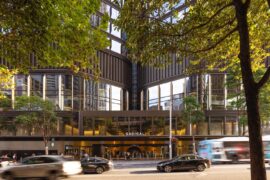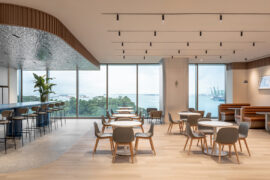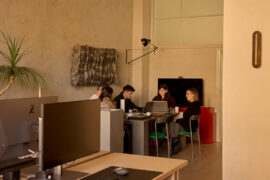The COVID-19 pandemic has indelibly changed the way we work, writes Gray Puksand’s Heidi Smith. The virus halted our daily routines and restrictions caused an enormous shift in the way we now do things, which is arguably here for good.

Heidi Smith, partner and workspace expert at Gray Puksand.
April 14th, 2022
The COVID-19 pandemic has indelibly changed the way we work. Not only has the virus itself halted our daily routines – with work, school, travel, social events – but the accompanying and ongoing restrictions have further caused an enormous shift in the way we do things that is arguably here for good.
The pandemic has enabled many people to reflect on their day-to-day lives and has changed perceptions of what is important. For many, this has inspired unhappy workers to quit their jobs and pursue a new role or long-held passion. For others, this has meant a new hybrid scenario of in-person and online work. For all, work is no longer merely being a thing we do, it has now become a way of how we approach our daily lives.
The ability to bring true flexibility to our day to day has been a freeing and empowering experience for many people. To be able to choose comfort, convenience and connection on our own terms is liberating. As we emerge from restrictions and lockdowns, we are seeing people establish their workstyle in a thoughtful and considered way. Establishing new patterns and daily routines, in particular, to emphasise their wellbeing, people are choosing how and when they engage with a brick-and-mortar office.

The workspace design industry will argue that we have been on this journey for decades, and whilst it’s true, we have, it took the global experience of the pandemic to forcibly lift the veil and reveal how successful hybrid work can be – for businesses and more importantly for individuals.
The design of workspaces has continued to evolve and develop even before the pandemic. In direct response to changing norms, emerging technologies and increasingly saturated markets, the built environment is an everchanging environment that faces the need for adaptation. The changing approaches to how we work, including the importance of collaboration, creative problem solving and mobile technologies, have only now been fast-tracked. Before the global pandemic, there was a booming interest and uptake of more agile and responsive workstyles. Many organisations had already been transitioning to or fully embracing workstyles that included Agile and Activity Based Working, however, perceived roadblocks remained for many organisations who were unable to imagine and conceive how an agile workstyle could be achieved for their workforce.
The result of lockdowns and restrictions experienced over the past two years has seen a big shift in this thinking from leaders and workers alike. The compulsory Work From Home experience has forced companies to adapt. Many organisations are finding that their staff are not only able to work remotely but there are even benefits to be found. The PWC Hopes and Fears Survey 2021 found “(f)lexible, remote working has accelerated as a result of the pandemic and the world of work has changed forever – the new world of work is hybrid. The ideal work environment for 74 per cent of Australians is a mix of remote and in-person working.”

This ideal Hybrid Workstyle is resulting in a complete rethink of what the office is – both its purpose and its physical expression. If workers can choose where they work from, and have access to equipment and technologies that support that decision, what will bring them to the office? What will encourage them to make that choice?
While many enjoy working from home and appreciate a flexible and hybrid style of working, the main reaction to the lockdowns of 2020 and 2021 was that a majority of people stated that they missed face-to-face interaction and the human connection that in-person work enabled.
Heidi Smith, Gray Puksand
Pandemic-informed design must cater to this first and foremost – the key to offering a compelling, first-choice destination workspace requires the locale where people know they will see their team and experience real-life connection as part of a greater purpose.
Research company Leesman Index undertook a comprehensive survey of 145,000+ workers who were working from home over the past two years. The Leesman Home Working Survey shows that “(r)emote working has drastically changed how different types of work activities can be supported.” The survey uncovered that Highly Collaborative tasks are considered better undertaken at the office (55 per cent), as opposed to Highly Individual tasks were better performed at home (61 per cent).

As a result, we are seeing the role of the office shift from being a place to undertake individual work at a fixed desk, to a destination that is wholly focused on collaboration with teams and connecting with colleagues.
This face-to-face connection has many benefits. Connection to your team is one thing, however, connection to purpose at work is another theme that has emerged as essential for employers and employees alike.
Heidi Smith, Gray Puksand
The pandemic has highlighted the importance of connection to purpose. The Great Resignation is one indicator of people choosing connection to purpose and their wellbeing over their jobs. NAB research uncovered that one in five Australians have changed their jobs in the last year. “Importantly, the research also found the key reasons people leave their jobs include lack of personal fulfilment, purpose or meaning, career limitations, mental health concerns and poor pay.”
Wellbeing is moving beyond lip service to becoming an essential element of the workspace of the future. By offering spaces for wellbeing in all its guises – fitness, meditation, healthy food, greenery – we can further enhance the office as a destination of choice.

We are seeing a demand for buildings to offer meaningful outdoor spaces – providing practical work setting options, permeable facades, and a true connection to nature via biophilic design. The inclusion of indoor planting, natural materials and access to fresh air and natural light will continue to inform workspace design. End of trip facilities is gaining more traction as people eschew crowded public transport for cycling to work.
Evidence showing that access to supportive work environments promotes happiness and feelings of productivity has been a driving force behind contemporary workspace design. This aspiration of wellbeing-focused working environments has been further emphasised during the pandemic experience, with concerns regarding isolation and disconnection driving focus on mental and physical wellbeing.
We believe the workspace of the future offers its people access to resources not available at home, beyond technology and equipment to true wellbeing, team collaboration, and social connection.
Heidi Smith is partner, and a workplace expert, at Gray Puksand.
Gray Puksand
graypuksand.com.au


We think you might like this article featuring key advice from Warren & Mahoney, Grimshaw and Elenberg Fraser on building a fluid workplace.
INDESIGN is on instagram
Follow @indesignlive
A searchable and comprehensive guide for specifying leading products and their suppliers
Keep up to date with the latest and greatest from our industry BFF's!

Rising above the new Sydney Metro Gadigal Station on Pitt Street, Investa’s Parkline Place is redefining the office property aesthetic.

London-based design duo Raw Edges have joined forces with Established & Sons and Tongue & Groove to introduce Wall to Wall – a hand-stained, “living collection” that transforms parquet flooring into a canvas of colour, pattern, and possibility.

The undeniable thread connecting Herman Miller and Knoll’s design legacies across the decades now finds its profound physical embodiment at MillerKnoll’s new Design Yard Archives.

For Aidan Mawhinney, the secret ingredient to Living Edge’s success “comes down to people, product and place.” As the brand celebrates a significant 25-year milestone, it’s that commitment to authentic, sustainable design – and the people behind it all – that continues to anchor its legacy.

With Steelcase having reopened its refreshed WorkLife Showroom in Singapore this year, we spoke to Navedita Shergill about some key workplace macro shifts identified in their research.

Bean Buro’s Singapore office for Anglo-Eastern is a poetic continuation of their Hong Kong headquarters — a workplace that balances identity and calm.
The internet never sleeps! Here's the stuff you might have missed

Founded by Ana Ćalić McLean and Josh McLean, In Addition is a design studio creating thoughtful, client-focused architecture and interiors.

David Gole, principal at leading climate-resilient design practice JDA Co., comments on the intersection between heritage and climate in architecture.